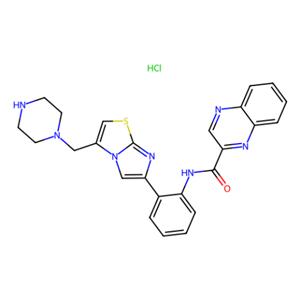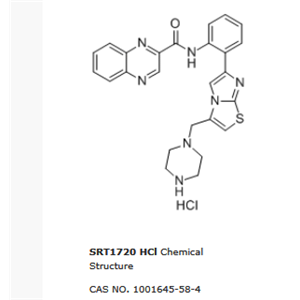| 名称 | SRT1720 hydrochloride |
| 描述 | SRT1720 hydrochloride (SRT1720 HCl) is a selective activator of SIRT1 (EC1.5: 0.16 μM) and shows less potent activities on SIRT2/SIRT3 (EC1.5s: 37 μM/300 μM). |
| 细胞实验 | Cell viability was assessed with a colorimetric assay using MTT as described previously. Apoptosis assay was quantified using Annexin V-FITC/Propidium iodide (PI) apoptosis detection kit, as per manufacturer's instructions, followed by analysis on FACS Calibur [3]. |
| 激酶实验 | In the SIRT1 FP assay, SIRT1 activity was monitored using a 20 amino acid peptide (AcGlu-Glu-Lys(biotin)-Gly-Gln-Ser-Thr-Ser-Ser-His-Ser-Lys(Ac)-Nle-Ser-Thr-Glu-Gly–Lys(MR121 or Tamra)-Glu-Glu-NH2) derived from the sequence of p53. The peptide was N-terminally linked to biotin and C-terminally modified with a fluorescent tag. The reaction for monitoring enzyme activity was a coupled enzyme assay where the first reaction was the deacetylation reaction catalyzed by SIRT1 and the second reaction was cleavage by trypsin at the newly exposed lysine residue. The reaction was stopped and streptavidin was added in order to accentuate the mass differences between substrate and product. In total, 290,000 compounds were screened and 127 hits were confirmed. The sensitivity of the FP assay allowed identification of compounds that exhibited low level activation of SIRT1 (≥17% activation at 20 μM) producing multiple classes of activators representing distinct structural classes. The fluorescence polarization reaction conditions were as follows: 0.5 μM peptide substrate, 150 μM βNAD+, 0-10 nM SIRT1, 25 mM Tris-acetate pH 8, 137 mM Na-Ac, 2.7 mM K-Ac, 1 mM Mg-Ac, 0.05% Tween-20, 0.1% Pluronic F127, 10 mM CaCl2, 5 mM DTT, 0.025% BSA, and 0.15 mM nicotinamide. The reaction was incubated at 37°C and stopped by addition of nicotinamide, and trypsin was added to cleave the deacetylated substrate. This reaction was incubated at 37°C in the presence of 1 μM streptavidin. Fluorescent polarization was determined at excitation (650 nm) and emission (680 nm) wavelengths [1]. |
| 动物实验 | Sirtinol (2 mg/kg) was administered by peritoneal injection, whereas SRT1720 (100 mg/kg) was administered through oral gavage 1 hour prior to CS exposure daily for 3 days. In a separate experiment, SRT1720 (25, 50, and 100 mg/kg) or PHA-408 (50 mg/kg) was dissolved in 0.5% carboxymethylcellulose containing 0.025% Tween 20 and injected via oral gavage into the conscious mice 24 hours prior to elastase administration, which was repeated daily (5 days per week) until 21 days after elastase administration. To study the therapeutic effect on emphysema, SRT1720 (100 mg/kg) was orally administered daily for 2 weeks after the development of elastase-induced emphysema [2]. |
| 体外活性 | SRT1720是SIRT1的激活剂(EC1.5 = 0.16 μM,最大激活率 = 781%)。相比于最接近的sirtuin同源体SIRT2和SIRT3,SRT1720对SIRT1的激活具有选择性(SIRT2:EC1.5 = 37 μM;SIRT3:EC1.5 > 300 μM)[1]。 |
| 体内活性 | SRT1720在小鼠(生物利用度=50%,终末半衰期=约5小时,曲线下面积(AUC)=7,892 ng h/ml)和大鼠(生物利用度=25%,终末半衰期=约8.4小时,AUC=3,714 ng/h/ml)中展示了适合体内评估的药代动力学特性。在DIO小鼠中,采用高脂饮食后,禁食血糖水平升高(范围120-150 mg dl1)。SRT1720的给药降低了经过1周治疗后的餐后血糖水平,并在3周治疗后进一步降低,此效果持续到10周给药期间。在腹腔内糖耐量测试中,SRT1720组的葡萄糖偏移也显著减少,与rosiglitazone(一种已被用于治疗2型糖尿病的PPARγ激活剂)相当[1]。SRT1720减轻了应激诱导的早期细胞衰老并且在小鼠中保护了免受香烟烟雾和弹性酶引起的肺气肿的伤害[2]。在动物肿瘤模型研究中,SRT1720抑制了MM肿瘤生长。SRT1720增强了硼替佐米或地塞米松的细胞毒活性[3]。 |
| 存储条件 | Powder: -20°C for 3 years | In solvent: -80°C for 1 year | Shipping with blue ice. |
| 溶解度 | H2O : < 1 mg/mL (insoluble or slightly soluble)
DMSO : 55 mg/mL (108.65 mM)
Ethanol : < 1 mg/mL (insoluble or slightly soluble)
|
| 关键字 | SRT-1720 Hydrochloride | SRT-1720 hydrochloride | SRT1720 hydrochloride | SRT1720 Hydrochloride |
| 相关产品 | Fisetin | Nicotinamide riboside | Nicotinamide | Resveratrol | Dihydrocoumarin | Sirtinol | JGB1741 | SRT 2104 | Nicotinamide riboside chloride | 3-TYP | SIRT6-IN-5 | MC3482 |
| 相关库 | 抗癌活性化合物库 | 经典已知活性库 | 已知活性化合物库 | 自噬库 | 组蛋白修饰化合物库 | 抗衰老化合物库 | HIF-1化合物库 | NO PAINS 化合物库 | 临床前化合物库 | 抗代谢疾病化合物库 |

![N-(2-(3-(哌嗪-1-基甲基)咪唑并[2,1-b]噻唑-6-基)苯基)喹喔啉-2-甲酰胺x盐酸盐](https://img.chemicalbook.com/SupplyImg/2024-02-20/Large/202402201433103854730.png)


